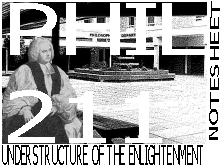 Hume 4
Hume 4
 Hume 4
Hume 4The difficulty in citing a miracle as a proof of God's existence lies in showing there is enough evidence to prove
(a) there is a universal law of nature; and
(b) x, which would, if it had happened, be an exception to the universal law, has in fact happened.
William Paley (1743-1805) the most well-known representative of this argument. If I encounter a watch among the pebbles on the beach we would conclude that here was something that could not have been assembled by chance.
Hume:
But
Once again Hume's scepticism derives its great power from his analysis of causation.
'It seems evident, that men are carried, by a natural instinct or prepossession, to repose faith in their senses; and that, without any reasoning, or even almost before the use of reason, we always suppose an external universe, which depends not on our perception, but would exist, though we and every sensible creature ewere absent or annihilated. ...
It also seems evident, that, when men follow this blind and powerful instinct of nature, they always suppose the very images, presented by the senses, to be the external objects, and never entertain any suspicion, that the one are nothing but representations of the other. ... But this universal and primary opinion of all men is soon destroyed by the slightest philosophy, which teaches us, that nothing can ever be present to the mind but an image or perception ...
It is a question of fact, whether the perceptions of the senses be produced by external objects, resembling them: How shall this question be determined? By experience surely; as all other questions of a like nature. But here experinience is, and must be entirely silent. The mind has never anything present to it but the perceptions, and cannot possibly reach any experience of their connexion with objects. The supposition of such a connexion is, therefore, without any foundation in reasoning.' Hume, Enquiry concerning human understanding, Section XII Part 1
Hume tries to account for the naive belief in the external world in the same way that he tries to account for the naive belief in causal necessity.
Oversimplifying:
Suppose I look at the brown lectern. Then I look away before looking back. I look at it every week. I think of this as my seeing one and the same object on several occasions. That is, I assume there is an enduring object which exists independently of me, one which is there when I am not looking at it as well as when I am.
One gloss:
'When some of our sense perceptions resemble each other, or when some of them occur together, and this happens repeatedly, Hume holds that the mind has a tendency to associate them together, and to consider them as unified. And it tends to project this unity beyond the period in which we actually perceive the impressions in question to be connected, and to regard them as having an enduring continuity and identity.' Schacht, Classical Modern Philosophers, Routledge, London and New York, 1984, p. 200.
A possible metaphor is this (though not actually Hume's):
We are patients surrounded by screens, upon which patterns move and change. It may be that some of these patterns are shadows thrown on the screens of objects beyond them: but we don't know, and, unable in principle to leave our beds, will never be able to tell.
Show that we have no grounds for thinking there are any real connections between things in nature and the bottom falls out of pretty well everything.
Newton: Philosophiae Naturalis Principia Mathematica, 'The Mathematical Principles of Natural Philosophy', 1687. The world system consisted of material bodies (consisting of groups of small hard particles) at rest or in motion and interacting acording to three laws of motion:
1. Every body continues in its state of rest or of uniform motion in a straight line unless it is compelled to change that state by forces impressed upon it.
2. The change of motion is proportional to the motive force impressed and is made in the direction of the straight line in which that force is impressed.
3. To every action there is always opposed an equal reaction; or, the mutual action of two bodies upon each other is always equal and directed to contrary parts.
To these principles he added the general law of gravitation, which in a modern formulation asserts:
Every particle of matter attracts every other particle with a force varyng directly as the product of their masses and inversely as the square of the distance between them.
VP